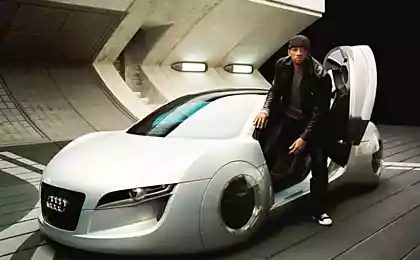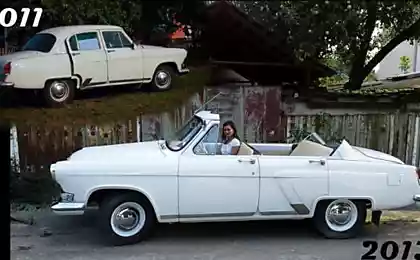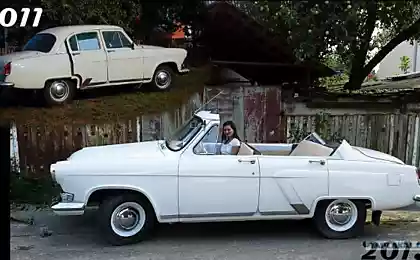819
When psycho minders
In the world of motor change is coming: a turbocharged present on all fronts inferior position imminent hybrid-electric future. And what was the past? Introducing the most insane and complex motors in automotive history.
Will 9 photo description +1 vidio
Fasting ends 1 spot!
Come
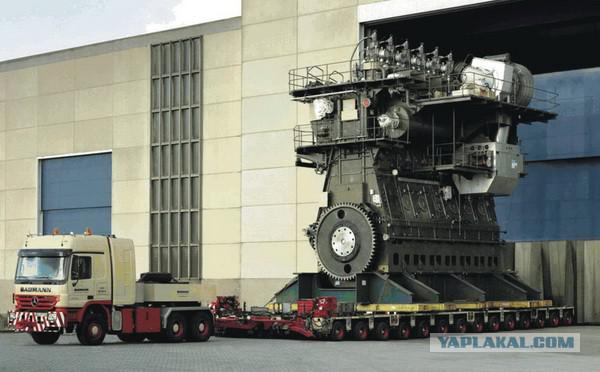
10th place. Volkswagen W8. Volkswagen engineers like to occasionally find weird, but interesting and elegant design solutions, and their eight-cylinder motor with a W- shaped layout - proof. In 1995, the engineers looked at from a new angle to their coarse canvas-shifted VR5 and VR6, borrowed some of the details, and in the end it turned out, two-Ryadno VR4 displaced with the angle of 15 degrees, merged together in one crankshaft. Camber between the blocks - 72 degrees. This arrangement allowed us to make 4, 0-liter engine is compact enough. Power - 275 horsepower. This engine is put on the fifth generation Passat in 2001, but high fuel consumption, and design complexity are not contributing to the popularity of so Passat W8 - a rare instance of a released was only 50 000 cars.
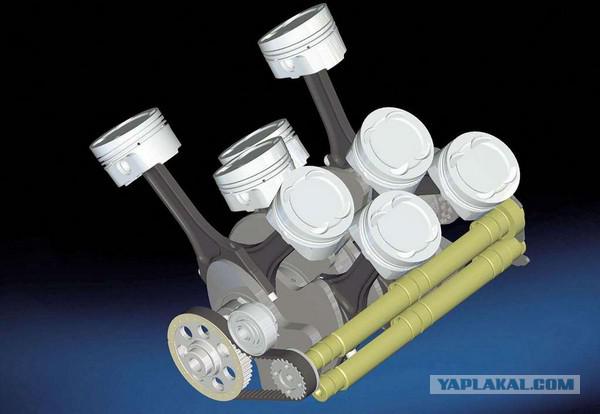
9th place. Lancia-Abarth Triflux. This engine, which is in the photo looks like a funny surprised robot is an attempt to Italian engineers to squeeze all the juice out of a volume of 1, 8 liters. Masters Abarth poshamanil with the location of valves and compact place two turbochargers working in parallel. The inlet and outlet valves are arranged in a checkerboard pattern, that is, on each side of the valve cylinder head has both. Accordingly, the exhaust manifolds were two. On the "lower classes" the entire volume of the exhaust gas fed to a turbine, and the second comes into play after the 3500 revolutions. This ensured a hurricane catch on the bottoms and practically did not give a chance turboyamu. As a result, the maximum power that developed the 1, 8-liter four-cylinder engine of 600 horsepower. That was twice as much as the rules allow the rally group S, for which the engine and prepared. However, to solve the problem of excess capacity of the Italians did not have: group S has not been established.
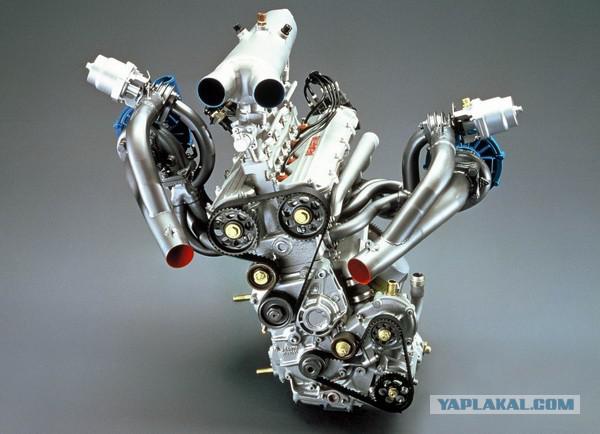
8th place. Nothing unusual, just turbodiesel called RTA96-C. If you do not take into account its size: the volume of a cylinder of 1820 liter maximum capacity - 108 920 horsepower. At speeds from 92 to 102 revolutions per minute the monster generates consciousness does not perceive the torque - Nm 7.603 million. Specific fuel consumption - 3, 8 liters. There is not one hundred kilometers, and for a second time. Motor weighs 2300 tons. Read these characteristics again, realize and move on to the next step.

7th place. Porsche Fuhrmann Type 547. This engine was designed for model Porsche 550. In 1954, the company decided that enough already to borrow development Vokswagen, it's time to create something of their own, very powerful motor, which could have been racing to Le Mans. Yes, and "folksvagenovsky" units by the time exhausted its potential. As a result, for the task in the project was brought Ernst Fuhrmann constructed intricate Type 547 - Boxer 1 5-liter engine with two carburetors. The cylinders were cast from an aluminum alloy, and the working surfaces were chrome plating. By virtue of its design, the engine was korotkohodnaya - cylinder with a diameter of 85 mm piston stroke length is 66 mm. Large diameter provides sufficient space to accommodate four valves per cylinder. As a result, the power range from 100 to 140 horsepower; about the same number of hours spent on it to collect one such engine.

6th place. Cizeta V16T. Italian supercar Cizeta V16T was intended to put on both blades Lamborghini. Design of machines involved Claudio Dzampolli and Marcello Gandini, who worked at Lamborghini. Standing under the hood of 16-cylinder naturally aspirated monster of 6 liters represented something like a sandwich: two V8 were paired together through a gearbox, as a result - two crankshaft four cylinder heads and camshafts eight. Here is such a 540-strong Italian sandwich costing under $ 1 million.
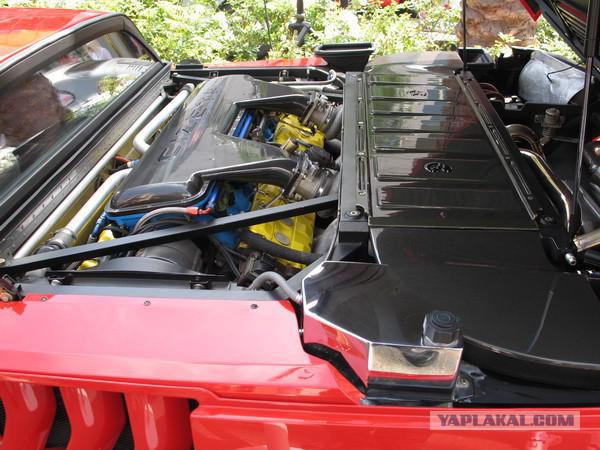
5th place. Saab variable compression. Motorists Saab around the world are known for their achievements: in 1976, the Swedes were the first to be installed in droves turbocharging, in 1983 - the first among European car manufacturers have mastered sixteen valves and overhead camshafts on production machines. Around the same time, in the eighties, we began the first experiments with the degree of compression. The technology is as follows: the cylinder head and cylinder liners are a single unit, which is put on the crank mechanism and can be moved by changing the volume of the cylinder. With an increase in the volume of work nadporshnevogo enters compressor cylinders catching up in the pressurized air. The volume change of the cylinder entails a change in the compression ratio in the case of Saab - from 8: 1 to 14: 1. The desired value is selected the engine control unit that monitors traffic conditions and the load on the motor. In 2000, assembled by the technology engine was capable of producing 225 horsepower at 1, 6-liter volume. From Sweden with love.

4th place. Cadillac 8-6-4. The first attempt to give the world Cadillac cylinder deactivation system to save fuel. In 1981, the American automaker began to produce six-liter V8, the volume of which can be arbitrarily reduced to 4, 5 liters (six-cylinder) or up to 3 liters (four cylinders). At idle the engine pistons pounding half, with gentle handling of the gas pedal are six of the eight cylinders, and with strong pressure on the gas pedal to connect all eight. However, the engine bad endured drops loads Troilus, gloh, and the system has already ceased to raise by 1983. Progressive desires do not coincide with technical capabilities.
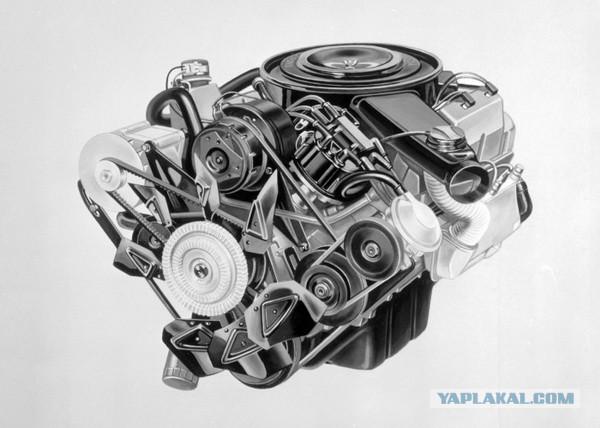
3rd place. BRM V16. Perhaps one of the most unusual in the history of engines in Formula 1. Its development began in 1949, a baptism of fire took place a year later. Today, after another 60 years, the characteristics of the engine seem to be something to the point of absurdity: V - shaped arrangement of 16 cylinders, compressor, 475 horsepower ... and 1, 5 liters of volume. The first race car with this engine ended a few meters - could not resist the driveshaft. Subsequently, the cars drove BRM effectively, sometimes even effective, but suffered from a chronic overheating, and manageability to the irrepressible power is also affected. Attempts to modernize and improve the engine led to the fact that in 1953 he was cleared absolutely indecent 600 horsepower, but it is more reliable than this, of course, did not.
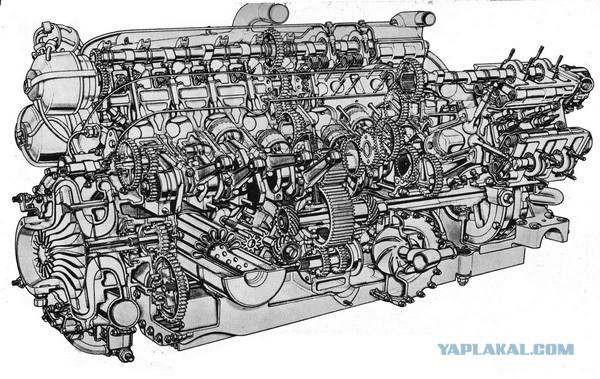
2nd place. Auto Union V16. The model made its debut in 1934. Designed by Ferdinand Porsche, 6-liter 16-cylinder engine with a compressor produces 520 horsepower and allows bolide accelerate to 340 kilometers per hour. Something to add pointless - just listen to the sound of this thoroughbred monster.
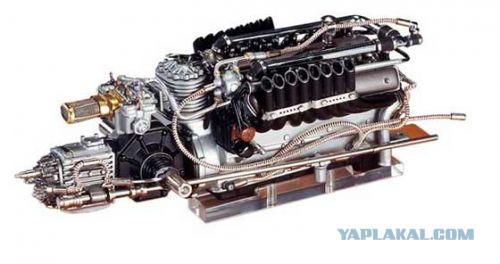
1 place. Adams-Farwell. Creation engineer Fay Oliver Farwell - a real mechanical exotic. This four-stroke rotary engine, the principle of which the designer borrowed from the mill. Although the feeling that he was just looking at a normal internal combustion engine and did the opposite: the crankshaft is arranged vertically and is rigidly fixed, and around his bearings spinning cylinders. The first prototype with an engine capacity of 25 horsepower was released in 1898. A few years later there was a five-cylinder version is issued in different versions 45-55 horsepower. Since 1910, such as the engines began to be used on the first helicopter design Emile Berliner. However, the originality and the high cost (the car was worth 5 times more expensive than the best-selling Ford T) led to the fact that 7 years have seen the light only 52 car. According to some estimates, up to now Adams-Farwell lived in a single copy.
I have everything.
Taken here
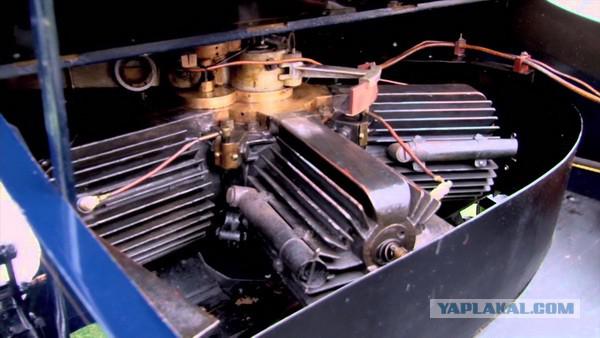
Source:
Will 9 photo description +1 vidio
Fasting ends 1 spot!
Come

10th place. Volkswagen W8. Volkswagen engineers like to occasionally find weird, but interesting and elegant design solutions, and their eight-cylinder motor with a W- shaped layout - proof. In 1995, the engineers looked at from a new angle to their coarse canvas-shifted VR5 and VR6, borrowed some of the details, and in the end it turned out, two-Ryadno VR4 displaced with the angle of 15 degrees, merged together in one crankshaft. Camber between the blocks - 72 degrees. This arrangement allowed us to make 4, 0-liter engine is compact enough. Power - 275 horsepower. This engine is put on the fifth generation Passat in 2001, but high fuel consumption, and design complexity are not contributing to the popularity of so Passat W8 - a rare instance of a released was only 50 000 cars.

9th place. Lancia-Abarth Triflux. This engine, which is in the photo looks like a funny surprised robot is an attempt to Italian engineers to squeeze all the juice out of a volume of 1, 8 liters. Masters Abarth poshamanil with the location of valves and compact place two turbochargers working in parallel. The inlet and outlet valves are arranged in a checkerboard pattern, that is, on each side of the valve cylinder head has both. Accordingly, the exhaust manifolds were two. On the "lower classes" the entire volume of the exhaust gas fed to a turbine, and the second comes into play after the 3500 revolutions. This ensured a hurricane catch on the bottoms and practically did not give a chance turboyamu. As a result, the maximum power that developed the 1, 8-liter four-cylinder engine of 600 horsepower. That was twice as much as the rules allow the rally group S, for which the engine and prepared. However, to solve the problem of excess capacity of the Italians did not have: group S has not been established.

8th place. Nothing unusual, just turbodiesel called RTA96-C. If you do not take into account its size: the volume of a cylinder of 1820 liter maximum capacity - 108 920 horsepower. At speeds from 92 to 102 revolutions per minute the monster generates consciousness does not perceive the torque - Nm 7.603 million. Specific fuel consumption - 3, 8 liters. There is not one hundred kilometers, and for a second time. Motor weighs 2300 tons. Read these characteristics again, realize and move on to the next step.

7th place. Porsche Fuhrmann Type 547. This engine was designed for model Porsche 550. In 1954, the company decided that enough already to borrow development Vokswagen, it's time to create something of their own, very powerful motor, which could have been racing to Le Mans. Yes, and "folksvagenovsky" units by the time exhausted its potential. As a result, for the task in the project was brought Ernst Fuhrmann constructed intricate Type 547 - Boxer 1 5-liter engine with two carburetors. The cylinders were cast from an aluminum alloy, and the working surfaces were chrome plating. By virtue of its design, the engine was korotkohodnaya - cylinder with a diameter of 85 mm piston stroke length is 66 mm. Large diameter provides sufficient space to accommodate four valves per cylinder. As a result, the power range from 100 to 140 horsepower; about the same number of hours spent on it to collect one such engine.

6th place. Cizeta V16T. Italian supercar Cizeta V16T was intended to put on both blades Lamborghini. Design of machines involved Claudio Dzampolli and Marcello Gandini, who worked at Lamborghini. Standing under the hood of 16-cylinder naturally aspirated monster of 6 liters represented something like a sandwich: two V8 were paired together through a gearbox, as a result - two crankshaft four cylinder heads and camshafts eight. Here is such a 540-strong Italian sandwich costing under $ 1 million.

5th place. Saab variable compression. Motorists Saab around the world are known for their achievements: in 1976, the Swedes were the first to be installed in droves turbocharging, in 1983 - the first among European car manufacturers have mastered sixteen valves and overhead camshafts on production machines. Around the same time, in the eighties, we began the first experiments with the degree of compression. The technology is as follows: the cylinder head and cylinder liners are a single unit, which is put on the crank mechanism and can be moved by changing the volume of the cylinder. With an increase in the volume of work nadporshnevogo enters compressor cylinders catching up in the pressurized air. The volume change of the cylinder entails a change in the compression ratio in the case of Saab - from 8: 1 to 14: 1. The desired value is selected the engine control unit that monitors traffic conditions and the load on the motor. In 2000, assembled by the technology engine was capable of producing 225 horsepower at 1, 6-liter volume. From Sweden with love.

4th place. Cadillac 8-6-4. The first attempt to give the world Cadillac cylinder deactivation system to save fuel. In 1981, the American automaker began to produce six-liter V8, the volume of which can be arbitrarily reduced to 4, 5 liters (six-cylinder) or up to 3 liters (four cylinders). At idle the engine pistons pounding half, with gentle handling of the gas pedal are six of the eight cylinders, and with strong pressure on the gas pedal to connect all eight. However, the engine bad endured drops loads Troilus, gloh, and the system has already ceased to raise by 1983. Progressive desires do not coincide with technical capabilities.

3rd place. BRM V16. Perhaps one of the most unusual in the history of engines in Formula 1. Its development began in 1949, a baptism of fire took place a year later. Today, after another 60 years, the characteristics of the engine seem to be something to the point of absurdity: V - shaped arrangement of 16 cylinders, compressor, 475 horsepower ... and 1, 5 liters of volume. The first race car with this engine ended a few meters - could not resist the driveshaft. Subsequently, the cars drove BRM effectively, sometimes even effective, but suffered from a chronic overheating, and manageability to the irrepressible power is also affected. Attempts to modernize and improve the engine led to the fact that in 1953 he was cleared absolutely indecent 600 horsepower, but it is more reliable than this, of course, did not.

2nd place. Auto Union V16. The model made its debut in 1934. Designed by Ferdinand Porsche, 6-liter 16-cylinder engine with a compressor produces 520 horsepower and allows bolide accelerate to 340 kilometers per hour. Something to add pointless - just listen to the sound of this thoroughbred monster.

1 place. Adams-Farwell. Creation engineer Fay Oliver Farwell - a real mechanical exotic. This four-stroke rotary engine, the principle of which the designer borrowed from the mill. Although the feeling that he was just looking at a normal internal combustion engine and did the opposite: the crankshaft is arranged vertically and is rigidly fixed, and around his bearings spinning cylinders. The first prototype with an engine capacity of 25 horsepower was released in 1898. A few years later there was a five-cylinder version is issued in different versions 45-55 horsepower. Since 1910, such as the engines began to be used on the first helicopter design Emile Berliner. However, the originality and the high cost (the car was worth 5 times more expensive than the best-selling Ford T) led to the fact that 7 years have seen the light only 52 car. According to some estimates, up to now Adams-Farwell lived in a single copy.
I have everything.
Taken here

Source:




